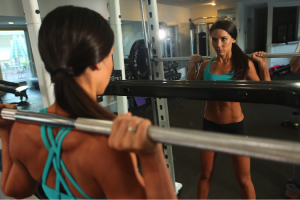Delayed Onset Muscle Soreness (DOMS) is such a fun topic :) Some people LOVE to be sore (me included) knowing that it’s a reward for a tough workout and that you really worked hard! Others HATE soreness and sometimes avoid difficult workouts for the fear of muscle soreness. Either way, we all need some relief sometimes!
First let’s talk about what causes muscle soreness. DOMS is a result of microscopic tearing of muscle fibers following significant exertion in the body. The amount of tearing depends on how hard and how long you exercise and what type of exercise you do. Heavy weight training often causes more intense DOMS due to all of the hard work our muscles have put into the workout. Although controversial, the buildup of lactic acid and resulting hydrogen ions (to buffer the acid) around the working muscle during intense exercise are also believed to be a factor in DOMS according to some experts. Of course, soreness (in moderation) is a very healthy sign of workout progress and not to be avoided. However, we need to listen to our bodies and make sure that we are not chronically sore from overtraining or pushing too hard.
So how can we control our soreness and make sure to still be able to function in the days following a tough workout?
- Active recovery: Go for a leisurely walk for an active rest day to get the lactic acid that has built up around your muscles moving. The WORST thing to do is lie around all day.
- Hydrate: I know you hear this time and time again, but muscles are largely composed of water and rely on hydration to function and recovery. Aim for at least 4 liters per day every day.
- Take L-glutamine with your post-workout meal: Glutamine is an amino acid that is made and stored in the body. During and after intense exercise the stores can sometimes become depleted making it difficult for the body to maintain nitrogen balance and encouraging DOMS. Include a heaping teaspoon of glutamine in your post workout shake to help minimize soreness.
- Use BCAAs before and after exercise: Glycogen stores are rapidly depleted during intense weight training sessions causing the liver to synthesize glucose by conversion of L-Alanine( one of the BCAAs). Providing additional BCAAs during times of stress on the body helps to allow protein synthesis to continue and therefore speeds up recovery. Supplementing with 5 grams of BCAAs before and after exercise will assist in muscle recovery.
- Use a foam roller on the sore areas: The stimulus of the roller against the muscles can give a great deep but controlled massage to relive tension. I find this to be especially useful for my lower body- calves, quads, glutes and hip flexors.
- Stretch or do yoga: One of my favorite things to do when my muscles are super duper sore is hot yoga. Not only does the stretch feel great, but the heat warms up the muscles so they are more limber and can stretch more comfortably and deeply. Although I don’t always enjoy the class itself my body feels so rejuvenated the next day!
- Get a massage: When I am most sore I make a trip to see my absolute favorite deep tissue massage therapist, Frieda. She has a VERY strong touch and although the massage itself is not always comfortable, my body loves it. She gets deep into the adhesions not only in my muscles but also fascia, tendons and ligaments that suffer from intense exercise.
Related: Why it’s time to throw out your light weights (lift heavy, get smaller)

